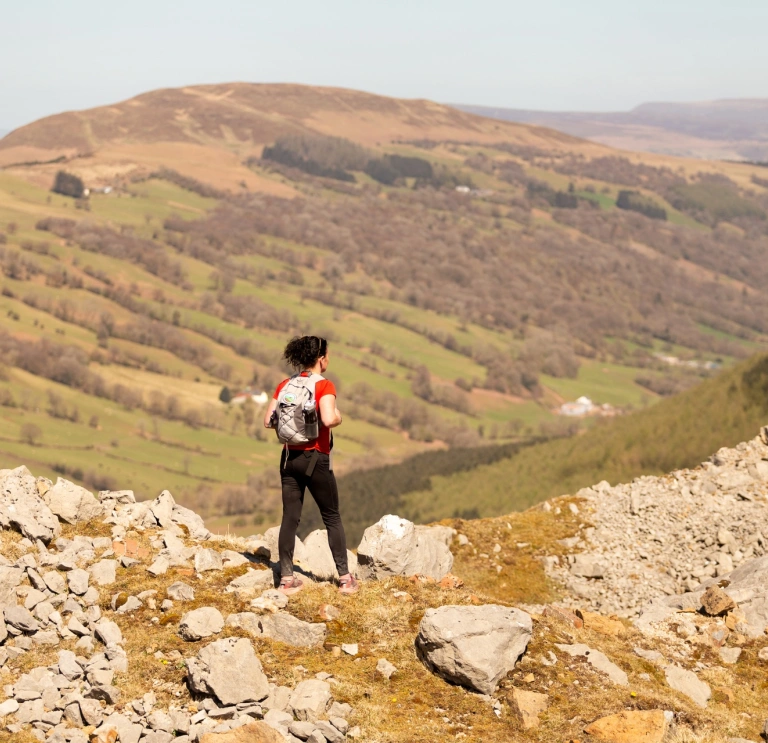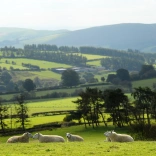Whether woven into the lyrics of timeless tunes or serving as a backdrop to beloved fantasy films, Welsh traditions, landscapes and famous figures pop up in all manner of modern art forms and continue to serve as a source of inspiration for creatives across the globe.
Here are eight examples of things originating from Wales that have influenced popular culture – some of which might surprise you!
The Mabinogion in Fleetwood Mac songs
‘This is a song about a Welsh witch’, declares Stevie Nicks in the opening of the official video to Fleetwood Mac’s classic 1975 tune Rhiannon. The ‘Welsh witch’ in question is the song’s namesake, Rhiannon, a sorceress who rides an uncatchable white horse in a series of medieval Welsh stories known collectively as The Mabinogion.
Though it’s not clear how much Nicks knew of the mystical tales of The Mabinogion when writing the 1975 hit, she became enthralled by the stories later in her career, penning another song, Angel, more specifically based on the Rhiannon character, and even purchased the rights to Evangeline Walton’s modern adaptation of the ancient texts. (We hold out hope for a Nicks-led film version in the future!)
The South Wales Valleys in Studio Ghibli
From Tokyo to Tredegar: legendary Japanese animator, and founder of Studio Ghibli, Hayao Miyazaki, turned to the South Wales Valleys – a region formerly synonymous with coal mining – for inspiration during the production of the studio’s debut release, Laputa: Castle in the Sky. Miyazaki made two trips to Wales while making the film in the 1980s, and based the film's fantastical industrialised setting on the Welsh mining towns he visited.

That’s not the studio’s only Welsh link, however. The fantasy novel Ghibli’s 2004 classic, Howl’s Moving Castle, is based upon, is partly set in Wales, and its protagonist, Howl, is actually Welsh: his real name is Howell Jenkins. It is thought that some smaller elements in Studio Ghibli’s other works were inspired by Welsh myths and legends.
A Welsh dog breed in British iconography
Thanks to being the companion of choice of Queen Elizabeth II, the corgi – a short, fluffy, and often cheeky breed of dog – has become a symbol of the British royal family (and, arguably, the country itself), taking centre stage in everything from commemorative mugs and plates to major motion pictures, such as The Queen’s Corgi.

Though this royal connection has led to corgis acquiring a reputation as a pampered pooch, the breed actually originated in the muddy fields of Wales, where they were used on farms for herding cattle. In fact, the name, corgi is thought to stem from a variation on the Welsh, Ci Corrach (Dwarf Dog), in reference to their diminutive size. Today, the two varieties of corgis, the Pembroke and the Cardigan, make for cherished pets all around the world, and are one of five native dog breeds from Wales.
The Welsh language in Lord of the Rings
‘What’s the Elvish word for friend?’ asks the hobbit Frodo outside the western gate of Moria in JRR Tolkien’s fantasy masterpiece Lord of the Rings. All fans know the answer (“Mellon!”), but fewer will know that the fictional Elvish language featured in the novel, and subsequent award-winning film trilogy, was based upon Welsh.

Tolkien had a great knowledge and deep appreciation for the Welsh language, which he taught while a professor at Leeds University, claiming it to be ‘the senior language of the men of Britain; Welsh is beautiful’. With Elves now a common trope in fantasy works, Tolkien’s Elvish tongue has spread with it, meaning a language with a distinctly Welsh lilt can be discerned in everything from Andrzej Sapkowski’s The Witcher Saga to Christopher Paolini’s The Inheritance Cycle.
Dylan Thomas in a Taylor Swift tune
Speculation was rife about who the songs in Taylor Swift’s 2024 album The Tortured Poets Department were written about. American football stars? Famous English rockers? Well, it’s actually a Welshman who takes centre stage in the chorus of the album’s title track, when the planet’s most famous songstress namechecks one of the world’s great poets, Dylan Thomas.


Despite passing away in 1953 at the young age of 39, Dylan’s exceptional talent and – self-perpetuated – image as a "doomed poet" has ensured his legacy lives on, drawing a new generation of readers to his works, which include poems like And death shall have no dominion and Do not go gentle into that good night. Dylan also has another high-flying musical connection, with the fabled American folk star Bob Dylan selecting his stage name as an ode to the Welsh wordsmith.
A Welsh pirate in the history books
Wales’ very own Blackbeard, Bartholomew Roberts was amongst the most successful pirates during the Golden Age of Piracy, capturing around 400 ships during his career (which, fittingly, came to an abrupt end during a naval battle when he was shot in the neck, and, as per his wishes, tossed overboard by his crew). He was also an early adopter of the ‘Jolly Roger’ skull and crossbones flag, which may have actually been named after him – the French referred to Roberts as Le Jolie Rouge (The Pretty Red) on account of his penchant for crimson-coloured clothing.
Robert’s notoriety and flamboyant personality, which were documented in the seminal 18th-century pirate biography A General History of the Pyrates, captured the imagination of the general public, and he remains a source of intrigue to this day, inspiring characters in everything from novels (The Devil's Captain by Frank Sherry) to songs (Barti Ddu by the Welsh band Bwncath), and even video games (Assassin's Creed: Black Flag).
A Welsh cottage in Led Zeppelin's discography
Imagine the typical lodgings of your average legendary rock band and thoughts of luxury pads in megacities like New York and Paris might spring to mind. But, when lauded British band Led Zeppelin were seeking some much-needed downtime, it was a small, off-grid cottage in Mid Wales they turned to.
Following a gruelling North America tour schedule, the band’s singer Robert Plant and guitarist Jimmy Page lived together at Bron-Yr-Aur, a rural 18th-century property on the outskirts of the town of Machynlleth, to recuperate. During their time at the cottage, the musicians were inspired to write a number of songs that featured on the band’s third and fourth albums, and dedicated two songs to the restorative rustic residence, Bron-Yr-Aur and Bron-Y-Aur Stomp. New music continues to be recorded at the cottage today.
Tom Jones in The Fresh Prince of Bel-Air
Sir Tom Jones is many things to many people, be it a musical megastar, sixties sex symbol, or, more recently, beloved talent show judge. But to American sitcom fans the Welsh icon may be famous for one of his lesser-known guises.
During the nineties, the enduring entertainer, who is famed for songs like She’s A Lady and Sex Bomb, made a guest appearance in the cult sitcom The Fresh Prince of Bel-Air, where he appeared as the guardian angel of the character Carlton Banks, played by Alfonso Ribeiro. In the episode, Sir Tom dispenses some much-needed life advice to a crest-fallen Carlton, before the two perform a duet of the singer’s 1965 breakout tune It’s Not Unusual, which was used several times throughout the show’s run – typically accompanied by the now iconic “Carlton” dance.





